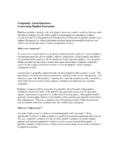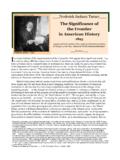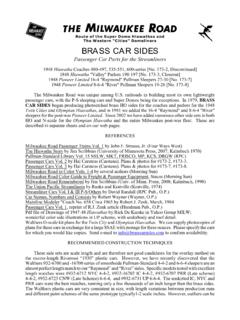Transcription of ''The City Image and its Elements - Seth Spielman
1 ''The city Image and its Elements " from The Image of the city (1960) Kevin Lynch Editors' Introduction Kevin Lynch (1918-1984), a professor of urban design at the Massachusetts Institute of Technology, is the towering figure of twentieth-century urban design. The Image of the city , from which this selection is taken, is the most widely read urban design book of all time. Drawing widely on material from psychology and the humanities, Lynch sought to understand how people perceive urban environments and how design professionals can respond to the deepest human needs. Lynch's rambling, profoundly humane writings weave together a unique blend of theory and practical design suggestions drawn from his voluminous reading in history, anthropology, architecture, art, psychology, literature, and a host of other areas.
2 This influential chapter on "The city Image and its Elements " presents Lynch's best known concepts on how people perceive cities. Lynch argues that people perceive cities as consisting of underlying city form Elements such as "paths" (along which people and goods flow), "edges" (which differentiate one part of the urban fabric from another), "landmarks" (which stand out and help orient people), "districts" (perceived as i:;hysically or culturally distinct even if their boundaries are fuzzy), and "nodes" where activities, and often paths, meet. Lynch believes that humans have an innate desire to understand their surroundings and do this best if a clear city Image is discernible from these Elements . If urban designers understand how people perceive these Elements and design to make cities more imageable, Lynch argues, urban designers can create more psychologically satisfying urban environments.
3 Lynch's research is a good example of creative qualitative research. Rather than starting from a theory and reasoning from it about how people perceive cities (deductive logic), Lynch started by gathering empirical information from people themselves and then constructing theory that explained the broad patterns he found (inductive logic). This is a common research strategy. Planners, for example, often conduct surveys to get people's opinions on a particular planning issue. What distinguishes Lynch's work from a run-of-the-mill survey report is his skill at generalizing what he found into high order conceptual categories rather than just reporting survey results. Lynch pioneered the technique of having people draw "mental maps" and analyzing them to understand how people perceived their surroundings.
4 Lynch came to his conclusions about the basic Elements of city form that shape perception largely by observing recurring patterns in the maps. Almost everyone drew streets and other geographical features along which people and goods moved. Lynch generalized these features into a category he named "paths". He also noticed that boundaries between parts of the city were often clear in the maps - and named this urban form element an "edge". Similarly Lynch created categories he called landmarks, nodes: and districts by generalizing repeating patterns he discovered in the maps ordinary citizens drew. Influenced by Lynch's work, urban designers in cities as diverse as San Francisco, Cairo, Havana, and Ciudad Guyana, Venezuela have sketched out the Elements of cities or parts of cities they are designing as paths, edges, t::E'.
5 !J KEVIN LYNCH nodes, landmarks, and districts - the underlying city form Elements that Lynch identified - and have used the~ries and practical suggestions about good city form to strengthen the Image of the cities in which they practice. Lynch used qualitative methods such as observation, interviews, and analysis of conceptual maps. Like man, architects and designers, Lynch was a good artist, who sketched aspects of the built environment both in schematic conceptual ways and as detailed line drawings. Urban design is a science as well as an art, and computers and computer assisted design (CAD) software have revolutionized the way in which urban design is done today. CAo software allows designers to create two-and three-dimensional renderings of urban space.
6 Using CAD softw urban designers can see and show others how a site, neighborhood or an entire city might be designed with the volumes and dimensions to scale and surfaces that look like the real thing. Three dimensional virtual reality sottww. makes it possible to "walk through" virtual designs and experience what they will be like. Like Lynch, other notable urban designers ground their practical design suggestions in underlying theory about human psychological needs. Compare Lynch's ideas about what people find psychologically satisfying and aesthetically appealing about cities with Camillo Sitte's ideas on planning public spaces according to artistic principles (p. 4 76) so that the entire city is a kind of outdoor art gallery. Note the similarities to Jan Gehl's emphasja on people's psychological need for contact with other people and his ideas about how thoughtful design of the space between buildings can encourage people to engage in more outdoor activities, increase social contact, and satisfy basic human needs (p.)
7 530). Observe how William Whyte grounds his imaginative applied principles for park and plaza design (p. 510) in theories about how people respond to the built environment around them even at a subconscious level. Consider how Frederick Law Olmsted based his practical suggestions about urban design in a broader vision that urban parks should provide oases of tranquility in which city dwellers could eacape the stress of city life and be spiritually refreshed (p. 321 ). Urban design draws heavily on the social science discipline of psychology, particularly the subfields 80 Ciml psychology and urban psychology. Urban psychology was pioneered by German psychologist George Simmet, who wrote a seminal essay titled "The Metropolis and Mental Life" in 1905.
8 Lewis Wirth's essay on "Urbanism a a Way of Life" (p. 96) builds on Simmel's work. Studies of how people perceive the personal space around them by University of California, Davis, psychology professor emeritus Robert Sommer are widely used by architecta and urban designers to inform them work. Unlike urban geography, urban politics, urban economics, and urban history, which are mainstream subfielda regularly taught in their respective departments, urban psychology remains a specialty taught in a minority of psychology departments. Culture is a particular concern of anthropologists. Some urban anthropologists study the way in which culture affects perceptions of space. Anthropologist Edward T. Hall developed the field of proxemics -how people in different cultures respond to the space immediately around them.
9 Kevin Lynch studied architecture at Yale University and apprenticed himself to Frank Lloyd Wright, the brilliant and opinionated architect who envisioned Broadacre city (p. 345) and was eventually recognized as one of the United States' greatest architects. Lynch received a bachelor's degree in urban planning from the Massachusetts Institute of Technology (Min in 194 7 and joined its faculty a year later. At MIT Lynch taught courses in urban design and site planning. He maintained an active urban design practice and, after publication of The Image of the city , cemented his reputation, lectured and consulted worldwide. In addition to The Image of the city (Cambridge, MA: MIT Press, 1960), Lynch's many books include a textbook on site design coauthored with Gary Hack, Site Planning, 3rd edn (Cambridge, MA: MIT Press, 1984), and boob on historic preservation, What Time Is This Place (Cambridge, MA: MIT Press, 1979), regional planning, Managing the Sense of a Region (Cambridge, MA: MIT Press, 1976), and his magnum opus, Good city Form (Cambridge.))
10 MA: MIT Press, 1991 ). Other of Lynch's writings are contained in Kevin Lynch, Tridib Banerjee, and Michael Southworth (eds), city Sense and city Design: Writings and Projects of Kevin Lynch (Cambridge, MA: MIT Press, 1995). Lynch's papers are in the Massachusetts Institute of Technology Library Archives and Special Collections, MC 208, Box X in Cambridge, Massachusetts. Classic and contemporary writings on urban design are collected in Michael Larice and Elizabeth Macdonald (eds), The Urban Design Reader (London: Routledge, 2006). Other books on urban design include Alex Krieger and William S. Saunders (eds), Urban Design (Minneapolis, MN: University of Minnesota Press, 2009), Lance Jay Brown, David Dixor York: Wiley, 2009), University of Washi1 Work (Columbus, C Brown, 1991) and : Cities (New York: V Design Associates, Psychologist Roi Hiss, The Experian< urban space.






